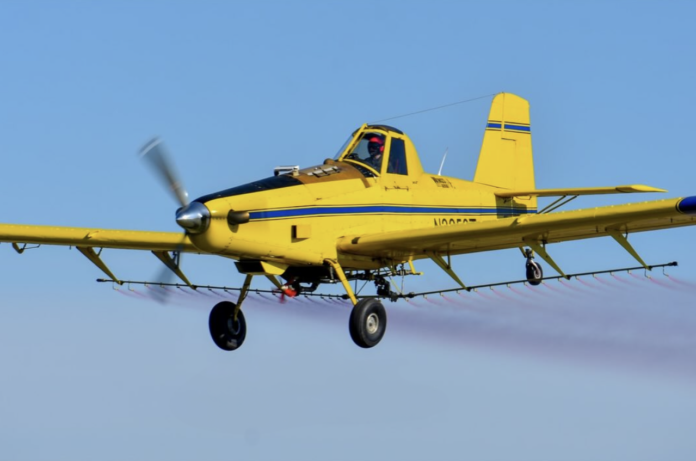by Hervé Marchadier
As we go through convention season every year, I’m struck by how young some new faces are. This is, of course, a function of how old I’m becoming. Even some of the people I thought of as “kids” when I started are starting to show a little gray in their beards. Some of the old-timers I remember when I started are no longer around. Naturally, I started wondering what the industry would look like in 10, 20, and 50 years.
Technology will change; that’s a given. The man who broke me out started with flashers, graduated to an Automatic Flagman, and retired with a GPS and a lightbar on his airplane. We’re seeing UASs more every year, variable-rate applications are becoming more common, and now you can have a map and a shape file wirelessly delivered to your airplane.
Overall, what doesn’t change is the people. This career attracts a wide range of people, but those who get in and stay around are rare. By and large, they’re willing to do the hard work this job requires. They are willing, enthusiastic even, to fly in an environment with a much smaller margin for error than most professional aviators.
There’s usually no shortage of people who think they want to do this; the question is how to train and prepare them for this lifestyle. That’s where Michael Ranspot and Tailwheel Training Center, located in Cameron, Texas, come in. Michael’s family has been involved in aerial application for three generations. Michael himself has flown for seventeen seasons. He’s also flown eradication in Colombia, instructed in the 802U, firefighting, and is now an airline pilot. He’s a man accustomed to operating in hazardous environments and doing so safely and efficiently. Ranspot started Tailwheel Training Center in 2021 because he wanted to teach new pilots not only how to do the work but also how to do it safely.
This isn’t just an ag school, though. It’s a real flight school. There are students here who have no plans to fly an ag plane. Michael has full-time instructors and maintenance, and he is more than happy to hang around and answer the myriad questions that come up occasionally. I came down for ten days to help him with some students and to see what this place is all about. I don’t typically fly much this time of year, and I keep my CFI current, so when he asked if I was free, I jumped at the chance. Not only have I known Spot for years, but I love this business, and having a chance to give back and pass along some lessons I’ve learned was impossible to pass by.
I got to Cameron in the evening, got my gear squared away, and returned early the next morning to get checked out in TTC’s Bellanca Scout, equipped with an AgPotX GPS and a lightbar. After my checkout flight, I could load my first student of the day and get to work. There is a variety of fields to work around the area, with a corresponding variety of obstacles, illusions, and other irregularities so that an aspiring ag pilot can start after learning the basics of turns, swath runs, etc., can start by “working” flat, open, square fields, and as they gain proficiency, they can move to more challenging fields with more obstacles.
My training philosophy is more or less naturally in line with Ranspot’s. I believe in the crawl, walk, and run method. We had days where we couldn’t fly because of weather, so my flock of fledgling ag pilots received ground training concerning the flying and the application portion. The actual flying is a small part of the overall skills required to be a proficient and professional applicator. Many students come here who already have
experience working as a member of a ground crew, but some also show up with no knowledge or prior experience.
The other day, it was a dreary day with low, ragged ceilings and gusty winds. After a long morning going over labels and quizzing the students about application rates, required PPE, etc, I dismissed my students for lunch. George Jones came on the radio as I drove into town to get a burger. The song was Who’s Gonna Fill Their Shoes. I realized that the men I was training were the ones who will carry the torch when, God willing, I retire. I try, as much as possible, to remember the things I wish I’d been exposed to during my training. It’s hard for any school to produce an applicator ready to work in all areas of the country or, in the case of international students, the world.
That’s been the biggest complaint I’ve heard from operators since I’ve been around. As such, I’ve tried to talk to the operators these men are working for, and since I’ve flown in the Midwest, the South, on rice, row crop, and pasture, and tailor some things to the individual based on where they are and what they do. I can’t think of a way to make a one-size-fits-all program.
This isn’t about me, however. This is about a man who decided he wanted to do his part to help reduce accident rates. This is about operators who send prospective pilots to that man. This is about the students and their transformation into trained aerial applicators, albeit on the basic level. All I’m doing, all Spot is doing, is laying a foundation anchored in safety and a constant quest to learn more and never settle for “good enough”. I’m coming to the end of my stint here. I miss my wife and kids. I am grateful to Michael for allowing me to come and help; perhaps I’ll make another trip down south. As for who’s gonna fill our shoes, I feel we’ll be just fine.





